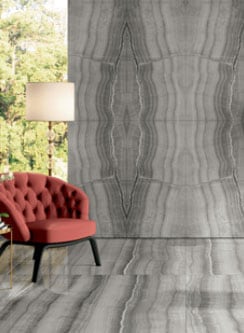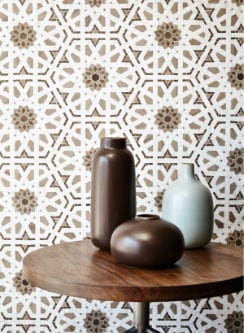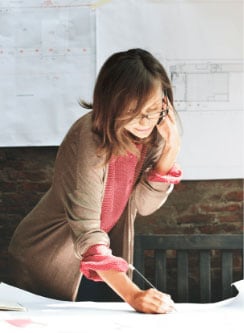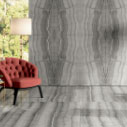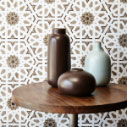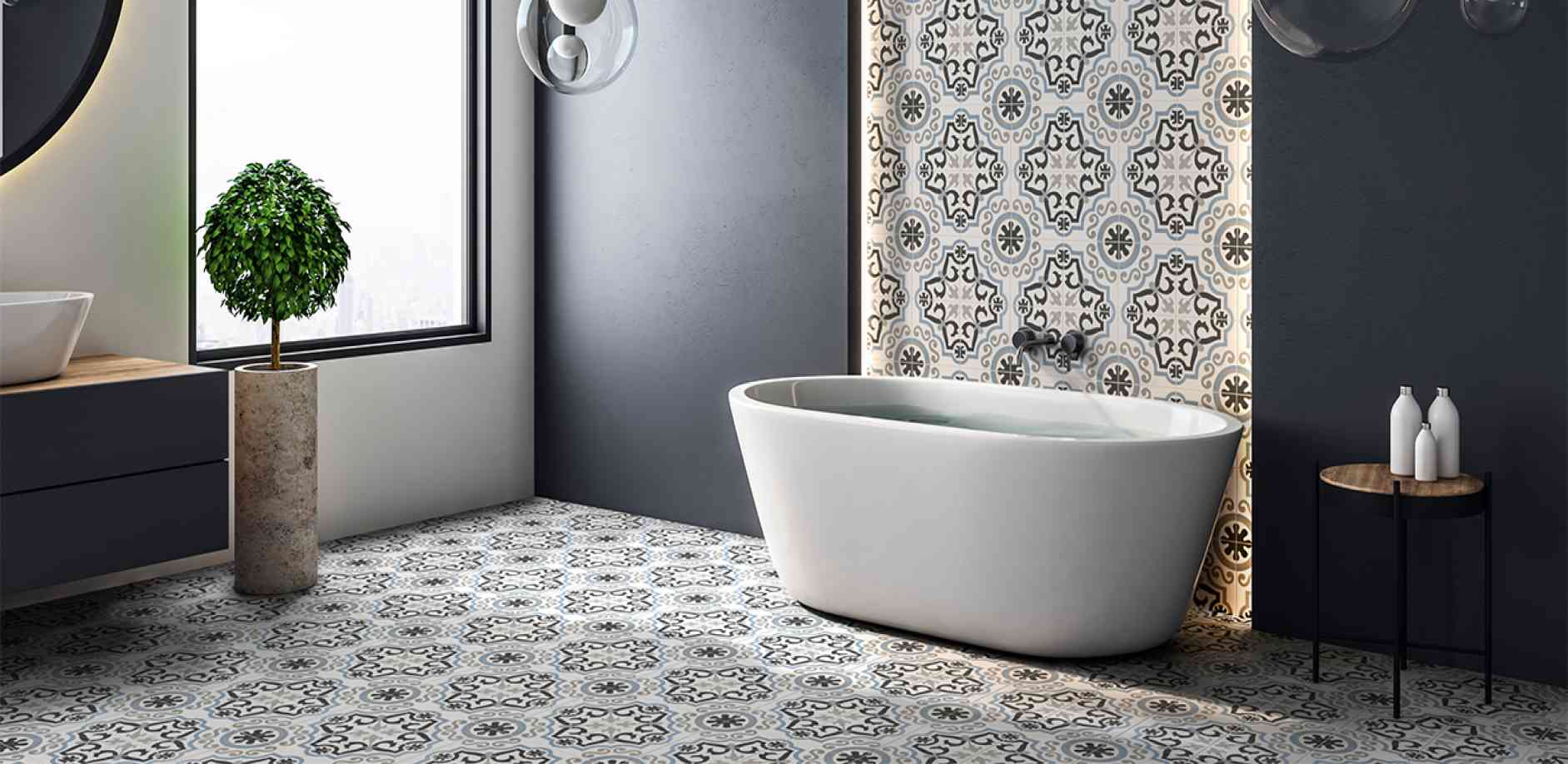
There’s a reason you notice cement tiles on the floors of iconic buildings in locations around the world. From the Los Angeles’s Union Station to the Central Lobby in London’s Houses of Parliament, cement tiles have universal appeal and a wide range of uses. An alternative to ceramic tile, with its smooth glossy surfaces, cement tile is more substantial, with a matte finish and famous for its bold designs. Cement tile produced through a time-honored artisanal process: natural pigment is added to dry cement before it’s poured into a metal mould. The cement is heated and hydraulically pressed, then allowed to cure for several days. In other words, no kiln drying. The uniqueness of this process results in a distinctive tile. Because the designs are embedded rather than painted on, they never wear away.
Sometimes referred to as encaustic or encaustic cement (although not associated with the encaustic wax painting technique), these tiles are thicker than ceramic, glass or porcelain tiles. Whether they’re used as floor tiles or in other design applications, they make an impression. Given the enduring quality of cement tiles, they’re an affordable choice for your home, meant to last and supply years of enjoyment. But there are some things you may not know about this remarkable design material.
1. Cement Tiles are More Than Just a Trend
While many in North America have only recently discovered cement tiles, they’ve been a mainstay of European design for over a century. Developed in Spain in the 1850s, then popularized in Paris at the International Exposition of 1867, cement tiles quickly gained popularity as an appealing option for the growing European middle class.
For the remainder of the nineteenth century, cement tiles were a staple of a genteel country home in France. In those days, a predomintent tile pattern was often matched with a contrasting border pattern to imitate the contrasting designs on a rug. That style traveled throughout the French colonial world, making an appearance in public buildings and private homes throughout Southeast Asia.
In Spain, the tiles were an update of the tradition which developed centuries earlier during the Moroccan presences in the country. While decorative ceramic Majolica tile is a cornerstone of Spanish architecture and design, the cement production process made these tiles a more affordable and accessible alternative. The trend traveled to Mexico, Latin America, and the Caribbean. In Cuba, cement tiles were so popular that they were sometimes referred to as “Cuban tiles.” They’re still widely used in the country today.
The cement tile hallway was a hallmark of design in the classic Victorian home in the UK and many of these floors are still in use. While the style evokes nostalgia, it has also inspired modern cement tile updates.
2. Cement Tiles Match Any Style
From the glamour of the Art Deco period to the warmth and vibrancy of a bohemian interior, decorative cement tile can help you achieve your design objectives. Bringing in an artisanal patterned cement tile can add a pop of color, a unifying element, or a decorative touch to a range of styles spanning centuries of time and extending around the globe.
Since the Art Deco style was popularized in 1920s, it has never truly gone out of style. With its streamlined silhouettes and geometric shapes and patterns, it expresses a bygone elegance that’s still fresh today. Hexagon cement tiles, for example, reference Art Deco style. They’re equally at home on a floor, backsplash or fireplace surround. Matched with a sleek set of finishes—such as marble countertops and gold or chrome hardware—cement tiles are an ideal way to inject Art Deco sophistication into your interior design. Paired with dramatic colors such as glossy black and jade green, you can achieve a sense of drama. Use tiles in neutral tones for contrast or bold geometrics for concentrated visual interest. With its strong diamond patterns in black, white, and grey, our Diamant Sarcelle pattern fits the bill.
Morocco has long been a source of inspiration for designers. With its long and rich tradition of patterned tiles, its vibrant colors and striking motifs are frequently interpreted in cement tiles. Arabesques, circular patterns, and ogees (a curved, onion-like shape with a point on each end), are just a few of the myriad geometric shapes can be artistically rendered in cement tile. The star or star and cross motif is a standby in Moroccan design, commonly found in everything from textiles to surface designs on buildings to metal and leather work. In tile, it’s often rendered in bright blues and yellows, but the classic vibrant tones of the tile can be toned down to fit in more easily with a muted palette. Moroccan-inspired cement tile such as our Parisian Blue or Marochina Diamant line adds a warm and casual element to any design scheme, from the contemporary to a more bohemian look.
Those are just a few examples of the stylistic range of cement tiles. If “cottagecore” is more your style, cement tile can introduce an informal element of pattern into your overall design and offer a contrast to materials such as wood and porcelain. Our Feuille Gris or Noir lines work in seamlessly. For ultra-modern interiors, cement tile softens a design scheme that’s heavy on concrete, stainless steel, and glass. A cement tile backsplash is an attractive alternative or complement to glass tiles. A cement tile floor breaks up the visual monotony of a neutral color scheme in any room of the house.
You don’t have to limit yourself to one pattern. Mix and match patterns in your installation for even more visual complexity. A small pattern adjacent to a larger looser one is a surprising choice that makes a lasting impact.
3. Cement Tiles Are Versatile
Whether you’re designing for an indoor or outdoor space, a wall or a floor, you can tie it all together with cement tiles. They add color and pattern scaled to complement your design in any room of the house and even outdoors.
In the kitchen, the floor is often the primary place to introduce pattern without overwhelming other finishes. A strong geometric pattern can lend a contemporary feel to the room, while a more delicate pattern points toward tradition. A cement tile kitchen floor is not only stylish, but practical, too. Cement tile floors can withstand the heavy traffic of a kitchen and are easy to maintain. In a kitchen with a monochromatic design, a cement tile backsplash becomes a centerpiece. The size of the pattern sets the tone—dramatic geometrics or delicate florals, for example, can influence the balance of the surrounding elements such as countertops and cabinets. A cement tile backsplash highlights the beauty of a quartz or marble countertop, projecting a sleek mood. Next to a warm wooden countertop and colorful cabinets, it can be homey and inviting. It’s easy to pair cement tiles with other textures, such as glass, porcelain, ceramic and stone.
The fireplace and mantle are always the focal point of a living room. Cement tile is a strong alternative to bricks, providing an opportunity to make a statement. Punctuating a monochromatic room, a bold tile pattern draws the eye and can even serve as substitute for a dramatic piece of artwork. It’s more affordable than a major piece of art, too. With a variety of patterns available in a range of scales, cement tile will reinforce a range of design styles or help point an otherwise neutral design in a deliberate direction. Use strong colors for drama, a delicate palette for a cozy look.
Cement tiles have been used in bathrooms for years. The classic application is a cement tile bathroom floor. It’s no wonder this option is so popular—it’s an attractive alternative to the traditional all-white bathroom and introduces color and pattern in a very livable way. But there are other options. Use it for the shower floor to provide a small, focused element of pattern. Or tile the shower wall for a contrast to a white or single-color tub. For a small space, a cement tile shower in a single pattern can create a unified and enclosed appearance. It’s especially appealing if you’ve got a stand-up shower. Because there are so many patterns available, you might try complimentary patterns in different spaces—a broad geometric on the floor to complement a smaller floral in the shower, for example. Cement tiles work in bathrooms of any size. In a small bathroom, they add interest within the limits of the space. In a larger bathroom, they can help to define different areas or add unity to a design. A cement tile bathroom is easy to clean and maintain. When properly sealed, cement tiles are waterproof, providing a worry-free solution for your flooring needs.
The utility of cement tiles doesn’t stop at the back door. In an outdoor room such as a patio, courtyard, or terrace, cement tile is an appealing alternative to concrete or cement. Outdoor cement tiles are a unifying element, allowing you tie home and finishes and color together. Go bold with a solid color on the walls and pick up complementary colors with a cement tile patio. Transform a bland outdoor room stylishly with pattern. A cement tile patio makes an outdoor entertaining space feel more like an outdoor room—an inviting space for your guests. If your aim to integrate your indoor and outdoor spaces, cement tiles can extend seamlessly from the kitchen to your outdoor entertainment area.
4. Cement Tiles Are Durable
There’s a reason cement tiles are found in so many historic homes and buildings—their quality stands the test of time. Cement tiles are made to withstand the wear and tear of heavy traffic areas and exposure to sunlight both inside and outside your home.
Cement tile floors are more durable than the ceramic tile alternative because they are made from a denser material. They don’t crack easily. They’re also stronger than hardwood floors, which are susceptible to waterlogging, rotting, and warping. Furniture leaves scrapes and dents in the surface of wood floors, but cement tiles resist such damage. Refinishing hardwood floors can be a costly undertaking. With cement floor tiles, you can avoid these pitfalls and enjoy a low-maintenance flooring material that’s as functional as it is beautiful.
Cement tiles don’t fade over time. The pigment in the tiles is fixed during the curing process. As the tile ages, it will eventually become richer and develop a slight ‘patina.’
With their enduring quality, you can expect cement tiles to function beautifully in your home for years.
5. Cement Tiles Are Easy to Maintain
Given the many design advantages of cement tile, many homeowners wonder how to clean and maintain this versatile product. With proper installation—which includes careful sealing—your cement tile floors will be easy to maintain for the long term.
Once you learn how to clean cement tiles, you’ll be able to preserve their beauty for the long term. If you have other natural stone surfaces in your home (such as terrazzo or slate), the method of cleaning cement tiles will be familiar to you. Basic cleaning involves nothing more than regularly sweeping and mopping with water and a non-acidic (Ph-neutral soap) and non-abrasive substance. You can try a product that’s specifically designed as a cement tile cleaner and apply it with a mop.
Certain foods or beverages such as wine or dark-colored soda have the potential to stain tile if the substance isn’t removed quickly. If stains do result, you can use a very fine sandpaper to buff out the stain and reseal. Tile stains can be removed through sanding and resealing and the process won’t damage the pattern that you’ve come to love.
With high-quality sealing, cement tiles are waterproof, but you should still avoid letting water stand on the surface.
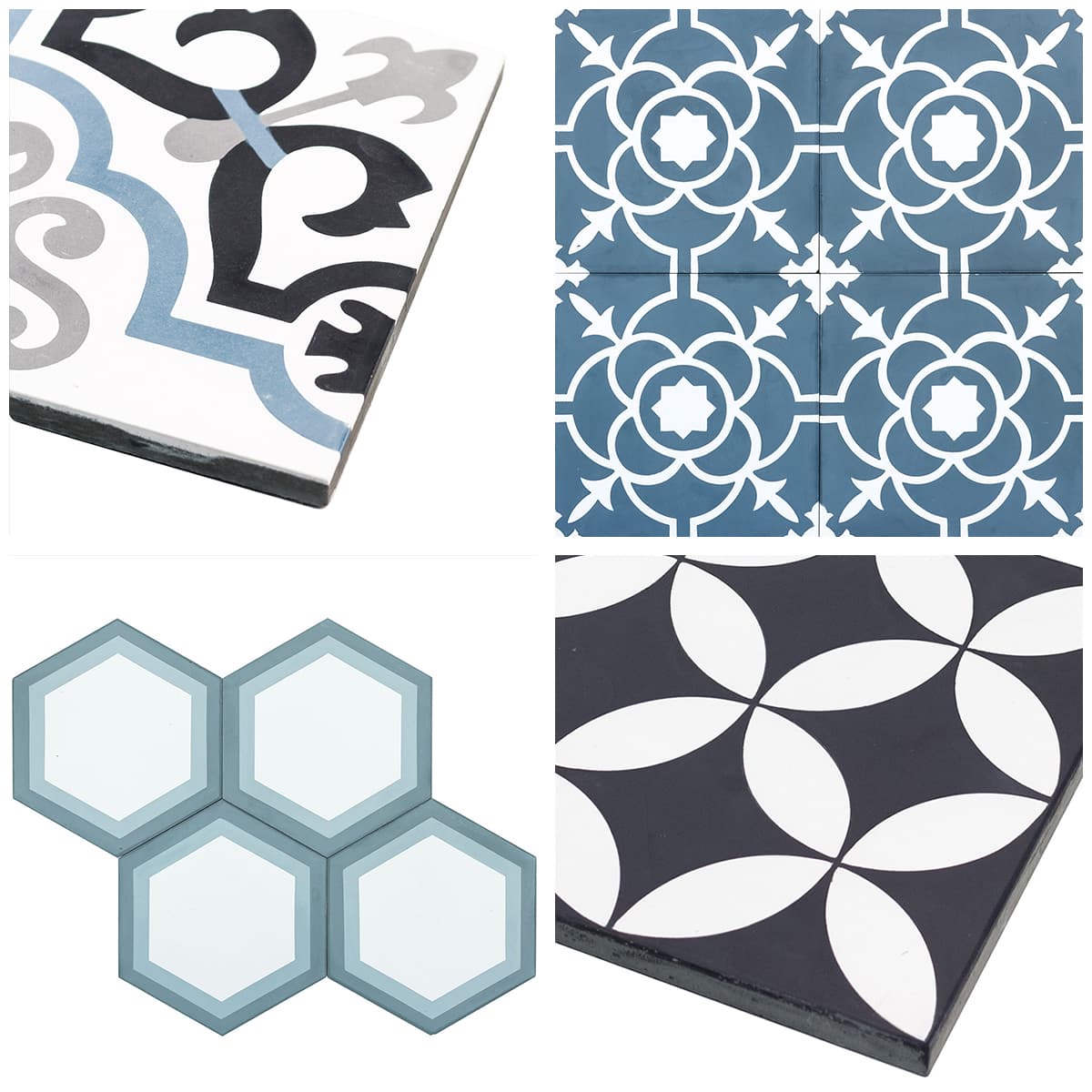
A cement tile floor is an enduring choice for your home, one that’s livable over the long-term while making a memorable statement. Now that you know more about cement tile, add this versatile material to your list of considerations for your design project. It’s a time-tested way to bring character and distinction into your home.













